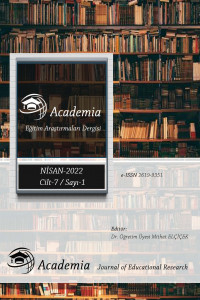Prizmaların Yüzey Alanı Üzerine Bir Durum Çalışması: Allosterik Öğrenme Modeli
Allosterik öğrenme modeli, Yüzey alanı, Prizmalar
Four in One: Optimism, Hope, Department Compatibility and Employability as Predictors of Career Adaptation
___
- Altun, A., & Olkun, S. (2005). Güncel gelişmeler ışığında ilköğretim matematik-fen-teknoloji-yönetim. Ankara: Anı Yayıncılık.
- Askew, C., & Field, A. P. (2007). Vicarious learning and the development of fears in childhood. Behaviour Research and Therapy, 45(11), 2616-2627.
- Berkant, H. G. & Gökçedağ, O. (2019). Allosterik öğrenme modelinin öğrencilerin fen dersine yönelik tutumlarına, güdülerine ve akademik başarılarına etkisi. Kastamonu Education Journal, 27(5), 2141-2159. doi:10.24106/kefdergi.3382
- Breslin, M. & Buchanon, R. (2008). On the Case Study Method of Research and Teaching in Design. Design Issues, 24(1), 36-40.
- Budak, Y. (2010). (Post Yapılandırmacılık) Allosterik Öğrenme Yaklaşımına Göre Öğrenme ve Eğitim Durumlarının Olası Niteliği. International Conference on New Trends in Education and Their Implications. 11(13), 468-473.
- Cooper, P.A. (1993). Paradigm shift s in designed instruction: From behaviorism to cognitivism to constructivism. Educational Technology 33: 12-19.
- Ezzy, D. (2002). Coding data and interpreting text: Methods of analysis. Qualitative analysis: Practice and innovation, 80-112.
- Flick, U. (1998) Qualitative Content Analysis. In An Introduction to Qualitative Research. Sage Publications Ltd, London, pp 192–198.
- Fraenkel, J. R., Wallen, N. E., & Hyun, H. H. (2012). Internal validity. How to design and evaluate research in education. New York: McGraw-Hill, 166-83.
- Giordan, A. (1995). New models for the learning process: Beyond constructivism?. Prospects, 25(1), 101-118.
- Giordan, A. (2010). Teaching and communicating Evolution: Proposals for innovative approaches and didactic researches. Biology International, 47, 40-47.
- Gojkov, G. (2011). Didactic limitations of constructivistic learning model in teaching. Metodički obzori, 6(13), 19-40.
- İşman, A. (1999). Eğitim teknolojisinin kuramsal boyutu: Yapısalcı yaklaşımın (constructivism) eğitim-öğretim ortamlarına etkisi. Öğretmen Eğitiminde Çağdaş Yaklaşımlar Sempozyumu, Dokuz Eylül Üniversitesi Buca Eğitim Fakültesi, İzmir.
- Krippendorff, K. (2004). Reliability in content analysis: Some common misconceptions and recommendations. Human communication research, 30(3), 411-433.
- Lachman, S. J. (1997). Learning is a process: Toward an improved definition of learning. The Journal of psychology, 131(5), 477-480.
- Lave, J. & Wenger, E. (1991). Situated Learning: Legitimate Peripheral Participation. Cambridge, MA: Cambridge University Press.
- Mayring, P. (2004). Qualitative content analysis. A companion to qualitative research, 1, 159-176.
- Merriam, S. B. (1998). Qualitative research and case study applications in education, San Francisco: Jossey-Boss.
- Moradi, M., Brunel, S., & Vallespir, B. (2008). Design a product for learning and teaching: From theories to developing a process. https://hal.archives-ouvertes.fr/hal-00323144 adresinden 12.11.2019 tarihinde erişilmiştir.
- Perkins, K. R. W. D., & Wirth, K. (2008). Learning to learn. University of North Dakota.
- Phillips, D. C. (1995, October). Th e good, the bad, and the ugly: The many faces of constructivism. Educational Researcher, 5-12.
- Stephan, M. (2015). Surface area. https://cstem.uncc.edu/sites/cstem.uncc.edu/files/media/files/stephan_surface_area.pdf adresinden 03.05. 2018 tarihinde erişilmiştir.
- Topbaş, E. (2007). Öğrenmeyi Anlamada Yeni Bir Model: Allosterik Öğrenme, 16. Eğitim Bilimleri Kongresi, 140-147.
- Topbaş, E. (2009). Gazi Üniversitesi ticaret ve turizm eğitim fakültesi büro yönetimi eğitimi bölümü ikinci sınıf öğrencilerinin beş basamaklı öğrenme stratejisine ilişkin görüşleri. 1. Uluslararası İktisadi ve İdari İncelemeler Dergisi, 3, 109-124.
- Topbaş, E. (2013). Allosterik Öğrenme Modeli ve Sınıf İçi Uygulaması. Öğrenme-Öğretme Yaklaşımları ve Uygulama Örnekleri, Pegem Akademi, Ankara.
- Wilson, S. M., & Peterson, P. L. (2006). Theories of learning and teaching: What do they mean for educators? (p. 2). Washington, DC: National Education Association.
- Yager, R.E. (1991). The constructivist learning model, towards real reform in science education. Science Education, 58(6), 52-57.
- Yin, R. K. (1994). Case study Research: Design and Methods. (2nd ed.). Thousand Oaks, CA: Sage
- Yayın Aralığı: Yılda 2 Sayı
- Başlangıç: 2016
Ortaokul Öğrencilerinin Fene Yönelik Kaygı Düzeylerinin Farklı Değişkenler Açısından İncelenmesi
Prizmaların Yüzey Alanı Üzerine Bir Durum Çalışması: Allosterik Öğrenme Modeli
Yeni Öğretmenler Odası Tasarımı Modeline Yönelik Öğretmen Görüşleri
Burcu ALTUNTAŞ, Seyithan DEMİRDAĞ, Hasan Yücel ERTEM
Türkçe, Matematik ve Fen Bilimleri Dersi Beceri Temelli Sorularına İlişkin Öğretmen Görüşleri
Cansu EBREN OZAN, Sevilay KARAMUSTAFAOĞLU
Eğitim Programları ve Öğretimde Karma Yönteme Dayalı Doktora Tezlerinin İncelenmesi
Murat GENÇ, Uğur ORHAN, Özlem ÖZCAN BAYKURT, Engin ÖZEL, Nursena İKİNCİ, Emel GÜRBÜZ, Merve TÜRK
